#edith garrud
Text
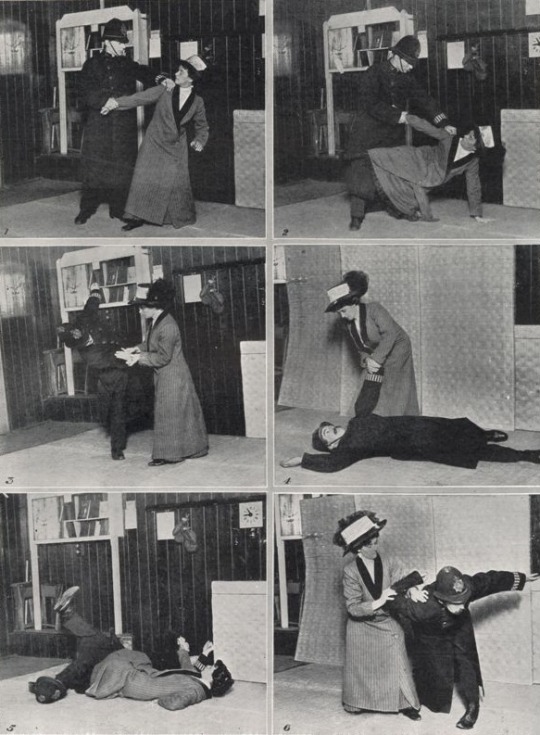
Edith Garrud - The suffragette that knew martial arts
The first British female teacher of jujutsu, Edith Garrud (1872-1971) taught the suffragettes to protect themselves.
A passion for martial arts
Edith Margaret Williams was born in Bath in 1872 and started her career as a physical instructor for girls. She shared this passion for physical culture with her husband, William Garrud, a wrestling and boxing instructor.
They came in contact with Edward Barton-Wright who had spent three years in Japan, and studied judo and jujutsu. He elaborated his self-defense techniques known as “bartitsu” and opened his club in London in 1899.
The Bartitsu Club was notably opened to women. Edith was thus able to train alongside her husband. By 1908, Edith and William became jujutsu instructors themselves with William in charge of the men’s class and Edith teaching the women and children.
Jujutsu specializes in speed, precision and the use of soft, flowing movements to deal with aggression rather than using just brute strength. The couple showcased their skills through demonstrations. In one of them, Edith defeated a male aggressor played by her husband. The sight of this 4ft-11inch (150cm) woman effortlessly throwing a much taller man greatly impressed the audience.
In 1907, Edith starred in a short film Jujutsu down the footpads in which an innocent lady overpowers two ruffians.
Vote for women
Edith took an interest in the cause of women’s suffrage. In 1909, she was invited by the Women's Social and Political Union (WSPU) to give a demonstration in the presence of Emeline Pankhurst and other leading figures of the movement. As William was ill, Edith demonstrated alone and invited members of the audience to test her skills. This included subjecting a skeptical police officer to a powerful shoulder throw.
In 1910, Edith also wrote a series of essays, advocating for the growing community of female martial artists and how self-defense could free women by giving them the means to protect themselves:
“You constantly read in the papers reports of dastardly attacks on helpless women by thieves and ruffians. A woman who knows jujutsu, even though she may not be physically strong, even though she may not have even an umbrella or parasol, is not helpless. I know many women personally who have tried the tricks I shall explain to you and come out on top. They have brought great burly cowards nearly twice their size to their feet and made them howl for mercy.”
The bodyguards
The suffragettes faced dangerous and violent situations. This was especially the case on Friday 18th November 1910. 300 WSPU members marched on the House of Parliament and faced police officers armed with batons. Women were subjected to six hours of beatings and arrests and there were widespread reports of sexual abuses.
Emeline Pankhurst thus asked Edith to train a group of women that would be known within the WSPU as the Bodyguard. Led by Gertrude Harding, they acted as agitators, disruptors and decoys.
Edith trained them in hand-to-hand combat and the use of homemade concealed weapons such as wooden India clubs and the fashioning of cardboard body armor. The suffragettes took advantage of their opponent's surprise and exploited their weaknesses.
They for instance struck directly at a police officer’s helmet to knock it from his head. Policemen were held accountable for the loss of uniform items and had to pay for their replacement. They cut the suspenders so that the policeman had to hold back his pants, blinded the police with a charge of umbrellas etc.
When told by a policeman that she was making an “obstruction” during a demonstration near the House of Commons, Edith pretended to drop her handkerchief, threw the policeman over her shoulder and disappeared into the crowd.
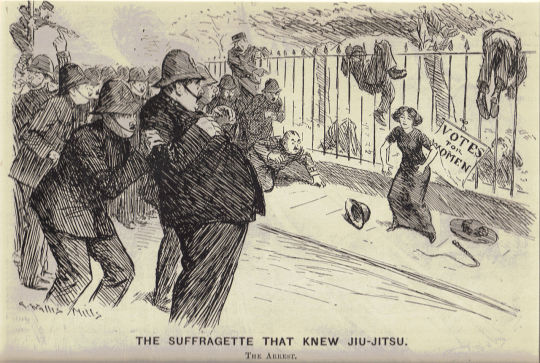
In prison, suffragettes went on hunger strikes and were subjected to force-feeding. The “Cat and Mouse Act” of 1913 allowed hunger-striking prisoners to be released and then re-incarcerated as soon as they had recovered their health. The Bodyguard thus protected and hid those women.
Edith for instance hid militant suffragettes in her dojo, telling the police not to disturb her lessons and leave her property.
A quiet retirement
Edith’s contributions to the suffragist movement ended with the beginning of the First World War. Little is known of her life afterward.
She and her husband would run the Golden Square dojo until their retirement in 1925 and retired to a quieter life. William passed away in 1960. In an interview in 1965, Edith said that her recipe for a long, happy and healthy life was:
“Self-discipline. Of course, I had to be extremely disciplined to succeed at jujutsu and hold my own with men […] but it is the mind which really has control, not only of your muscles and your limbs and how you use them, but also your thoughts, your whole attitude to life and other people.”
She died in 1971. A plaque on the building that had been her home can be seen today: “Edith Garrud 1872–1971. The suffragette who knew jiu-jitsu lived here”.
Further reading
Dorlin Elsa, Se défendre : une philosophie de la violence
Godfrey Emelyne, Femininity, Crime and Self-Defence in Victorian Literature and Society: From Dagger-Fans to Suffragettes
Kelly Simon, "Edith Garrud: The jujutsuffragette". In McMurray, Robert; Pullen, Allison (eds.), Power, Politics and Exclusion in Organization and Management
Ruz Camila, Parkinson Justin, ““'Suffrajitsu': How the suffragettes fought back using martial arts”
#history#women in history#women's history#feminism#suffragettes#20th century#edith garrud#martial arts#jujutsu#jiujitsu#england#english history#herstory#women in martial arts#historical figures
85 notes
·
View notes
Note
Maggie, I was reading about the Suffragettes today and I found something that reminded me of your Eleanor. As the movement took a violent turn, Emmeline Pankhurst urged all suffragettes to learn some form of self defence. At the time, the most effective means was jujitsu, which was taught in police training. Thanks to Edith Garrud, the first British female jujitsu instructor, hundreds of women learned to protect themselves. The term “suffrajitsu” came into use, and inspired cartoons like the one below.

I’ve been smiling all day picturing Eleanor strike fear into the hearts of London policemen to the point that she became an urban legend.
Oh I LOVE this.
19 notes
·
View notes
Text
"Harding’s first big ‘job’ was to stage a midnight attack on rare orchids with comrade Lilian Lenton at the Royal Botanical Gardens in Kew (Lilian soon became a daring arsonist for the cause). The women entered the Gardens by day, posing as tourists, and discovered the best places to attack. That night, during a thunderstorm, they broke into two little glass houses with the rarest orchids, intent on wreaking as much damage as possible before being caught. The night watchman didn't come. The next day a dozen newspapers reported ‘the outrage' at Kew Gardens, two claiming it must have been male sympathizers to the cause, as only men could scale the six-foot wall to escape.
Gert Harding started working on the newspaper, The Suffragette, when Headquarters at Lincoln's Inn was raided by Scotland Yard and the paper driven underground. Of greatest note in her career with the WSPU is that Harding was asked to 'head up' the secret bodyguard of women assigned to protect their leader, Mrs Emmeline Pankhurst, from constant rearrest by Scotland Yard during the Cat and Mouse Act. The bodyguard learned jujitsu from Edith Garrud and carried Indian rubber clubs. Despite this, the women often were badly injured, from contusions to broken bones, dislocated joints and concussions. Their best successes against bobbies and Scotland Yard detectives came from outwitting them, using disguises, decoys and other forms of subterfuge. On two occasions, a decoy 'Mrs Pankhurst' was arrested, allowing the real Mrs Pankhurst to escape undetected."
#Gertrude Harding#Gertrude Menzies Harding#United Kingdom#activist#women#history#interesting ladies on wikipedia
1 note
·
View note
Text
Today I learned about... suffrajitsu.

(images courtesy of Wikipedia)
"Suffrajitsu" was the name given to the self-defense technique used by members of the Women's Social and Political Union during the suffragette marches in Britain in 1913-1914.
Edith Garrud (shown in the pictures above), one of the first women in the Western world to become an instructor in the martial arts, taught the technique to her fellow WSPU members as a way to defend themselves against police when they attempted to break up their marches through violent means.

(image courtesy of Wikipedia)
She also trained the thirty women who became known as The Bodyguard (sometimes referred to as "Amazons" by the press at that time) who functioned as the personal protection force for WSPU leader Emmaline Pankhurst.
And it goes without saying...if a husband got a little, shall we say, too full of himself...
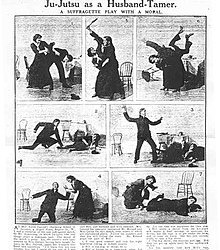
(image courtesy of Wikipedia)
Here's the link to the Wikipedia article, makes for some great reading:
80 notes
·
View notes
Text






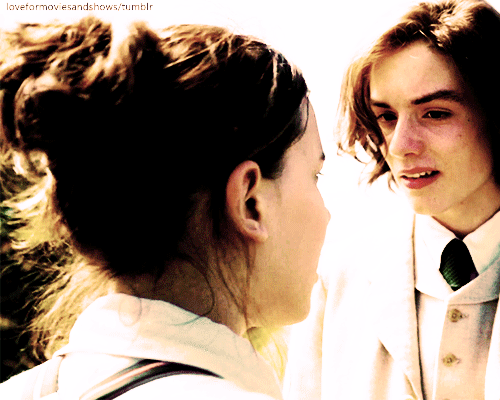


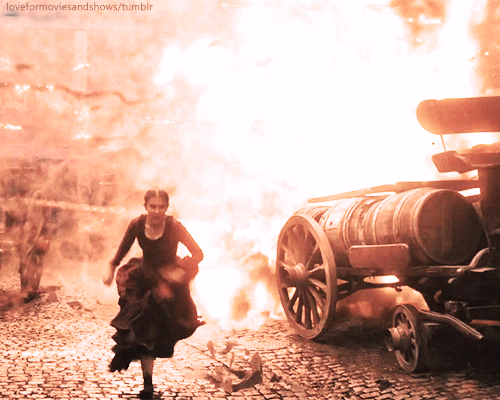

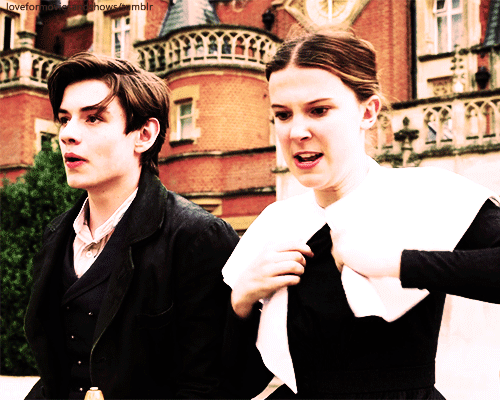




Enola Holmes | (2020)
#enola holmes#millie bobby brown#helena bonham carter#eudoria#eudoria holmes#enola#lord tewksbury#louis partridge#tewkesbury#enola x tewkesbury#henry cavill#sherlock holmes#sam claflin#mycroft holmes#susan wokoma#edith#Edith Garrud#my gifs
220 notes
·
View notes
Text
So I found out about this on a Brazilian Jiu-Jitsu subreddit.
I remember someone here made a post detailing the history of suffragettes/feminists. Because of police harassment suffragettes/feminists were encouraged to train in martial arts for defense. Edith Garrud would form and teach the "suffragette self defense club" in 1909.
I can't find much on the techniques of suffrajitsu but from the images you can see them perform locks, sweeps, and throws.
#suffrajitsu#women's suffrage#suffragette#suffrage movement#feminist#radblr#radical feminists please touch#mma#mmalifestyle#juijitsu#bjj#judo#edith garrud
5 notes
·
View notes
Text
Edith Garrud: Suffrajitsu
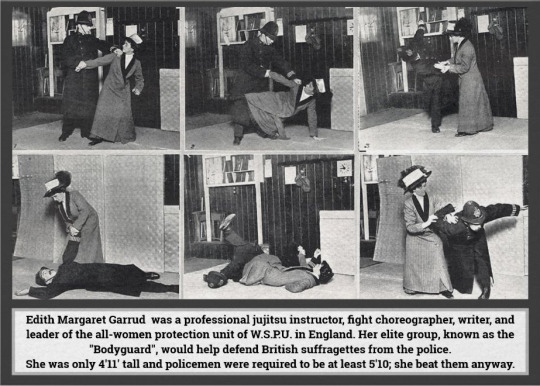
English suffragette Edith Maragret Garrud (1872-1971) was a professional jiu jitsu instructor, writer, fight choreographer, and leader of the “Bodyguard”, an elite all-woman fighting group that protected members of Emmeline Pankhurst’s group, the Woman’s Political Suffrage Union (WPSU).
In 1899, Garrud and her husband, a boxing and wrestling instructor, were introduced to the martial art of jiu-jitsu by Edward William Barton-Wright, the very first jiu jitsu teacher in Europe. By 1908, she and her husband took over Sadakazu Uyenishi’s Golden Square School in London when the famed instructor wanted to return to his native Japan. Garrud taught the classes for women and children. She and her husband did popular exhibitions of the art and wrote articles about it for newspapers and magazines. Garrund choreographed fight scenes for a play and had a film role.
In 1908, she also started teaching suffragettes how to defend themselves against police. The term “suffrajitsu” came into use. By 1913, after the police continually arrested, jailed, released, and arrested leaders of the British suffrage movement over and over again, Garrund stepped into form the “Bodyguard” team. This team not only had several hand-to-hand fights with the police department, they also helped suffragettes escape through the use of subterfuge and decoys. Once the police thought they had arrested Emmeline Pankhurst and when they lifted her veil it was another woman--a decoy. The real Pankhurst had escaped arrest.
https://www.thesuffragettes.org/map/london-boroughs/westminster/edith-margaret-garrud/
https://www.bbc.com/news/magazine-34425615
Here are some short vintage films of women using Jiu Jitsu as defense
“Hints to the Ladies on Jiu-Jitsu (1926)
https://youtu.be/tpDmcxOSuas
“The Weaker Sex” (1933)
https://youtu.be/-GJsld9IVjU
Women Self Defense (1947)
https://youtu.be/SbFtFaNkXCc
#suffragettecity100#fightforthe19th#edith garrud#edith margaret garrud#jujitsu#jiu jitsu#ju jitsu#women ninjas#ninja#self defence techniques#pankhurst#Sadakazu Uyenishi#suffrage movement#emmeline pankurst#suffagette#suffragist#edward william barton-wright#london#british history#g.l.o.w.#martial arts#MMA#valuethevote
2 notes
·
View notes
Photo

28 notes
·
View notes
Quote
Woman is exposed to many perils nowadays because so many who call themselves men are not worthy of that exalted title and it is her duty to learn how to defend herself.
Because ju-jutsu has over and over again been proved to be the most effective means in moments of emergency for repelling the attack of a ruffian.
Because it is easy to learn, and because it is, quite apart from its combative value, a splendid exercise. It is the very thing for women as well as men to take up thoroughly.
Edith Garrud (Jujitsu teacher to the Suffragettes)
29 notes
·
View notes
Video
youtube
Drunk History - Emmeline Pankhurst and Edith Garrud
#drunk history#london 1900s#1900s#feminism#suffragette#womens suffrage#emmeline pankhurst#self defense#jiujitsu#womens rights#edith garrud
1 note
·
View note
Photo

Edith Garrud was a tiny woman. Measuring 4ft 11in (150cm) in height she appeared no match for the officers of the Metropolitan Police - required to be at least 5ft 10in (178cm) tall at the time. But she had a secret weapon.
In the run-up to World War One, Garrud became a jiu-jitsu instructor to the Women's Social and Political Union (WSPU), better known as the suffragettes, taking part in an increasingly violent campaign for votes for women.
Sick of the lack of progress, they resorted to civil disobedience, marches and illegal activities including assault and arson.
...
#femminism#suffragette#edith garrud#women's social and political union#wspu#england#great britain#civil disobedience#martial arts#acab#ju jitsu
61 notes
·
View notes
Photo
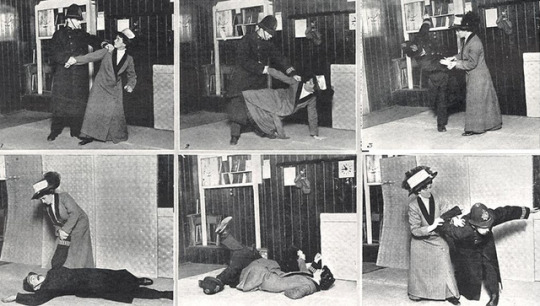
#1 Edith Garrud, 1872-1971
Brilliant for: one of the first female martial arts instructors in the UK, Edith Garrud trained suffragettes in Ju-Jitsu and self-defence.
"Physical force seems to be the only thing in which women have not demonstrated their equality to men, and whilst we are waiting for the evolution which is slowly taking place and bringing about that equality, we might just as well take time by the forelock and use ju-jitsu."
2 notes
·
View notes
Photo

Illustration de Arthur Wallis Mills (1910)
Edith Margaret Garrud (1872–1971) est l'une des premières femmes professeur d'arts martiaux en Europe. Elle est connue pour avoir entraîné une unité de gardes-du-corps pour la Women's Social and Political Union aux techniques de jujitsu.
1 note
·
View note
Photo

💚♥️💛💙🧡 Vivantes ! Réflexions critiques sur la représentation des femmes dans l’art et son histoire, ci-éditions @fracmeca et @actessud : Textes et entretiens absolument passionnants où l’on croise Louise Bourgeois, Rosa Bonheur, Marie Darlanne (muse et modèle de Félix Arnaudin), la méconnue et magnifique peintre Eva Gonzalès, Joséphine Baker, la Venus de Brassempouy, Edith Garrud (grande maîtresse de Jujitsu au début du XXème siècle) ou bien encore l’exceptionnelle Nancy Cunard, poétesse, collectionneuse d’art africain, éditrice notamment de la Negro anthology (un monument publié en 1934 qui dénonce l’esclavage, les clichés racistes sur l’Afrique et la discrimination raciale aux Etats-Unis) ! #art #feminisme #beauxarts #librairie #mollat #bordeaux (à librairie mollat) https://www.instagram.com/p/CbFgV8gKViE/?utm_medium=tumblr
3 notes
·
View notes
Photo


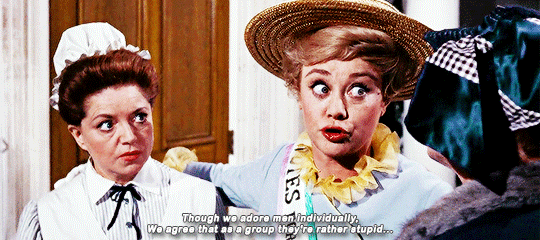


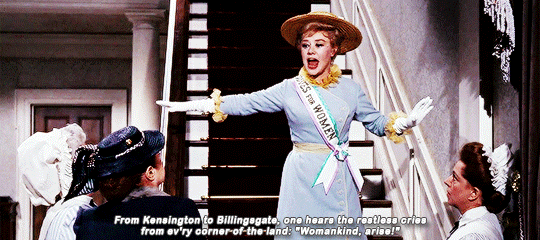

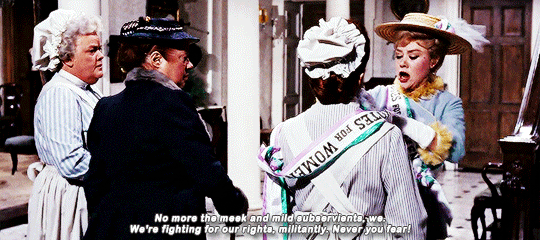
Your daughters’ daughters (and their daughters) adore you! Well done, Sister Suffragette!
‘We’re fighting for our rights, militantly.’
The suffragettes weren’t a peaceful political party but a militant organisation. They were going to get the vote and by any means necessary. They performed hunger strikes, broke into parliament with weapons and were even responsible for arson. Their motto was “Deeds not words”.
The term ‘suffragettes’ was first used by the Dail Mail (a right wing UK newspaper) to ridicule the women of the WSPU organisation, lead by Emily Pinkhurst, but the women took the term and embraced it and changing it to “SuffraGets” suggesting not only do they want the rights to vote by they will get it.
Emmeline Pankhurst found the organisation and was arrested numerous times for her demonstrations, Leonora Cohen smashed the display case for the Crown Jewels in the Tower of London, Emily Davison died after stepping in front of a King’s horse in 1913, Constance Markievicz became the first woman elected to the British House of Commons though she didn’t take her seat as an Irish liberation activist, Princess Sophia Duleep Singh became an activist after seeing the horrors committed by the British on a trip to her home nation, India.
Thank you to Emmeline Pankhurst, Christabel Pankhurst, Emily Davison, Princess Sophia Duleep Singh, Edith Garrud, Leonora Cohen, Millicent Fawcett, Constance Markievicz and the women of the Women’s Social and Political Union for fighting for women’s rights to vote.
Wealthy women who owned property received the right to vote in 1918 and all women aged 21 and over (same as men), regardless of wealth, in 1928 (1928 Equal Franchise Act).
#mary poppins#perioddramaedit#history#historyedit#suffragettes#feminism#forgive me for any errors#Miscedit
2K notes
·
View notes